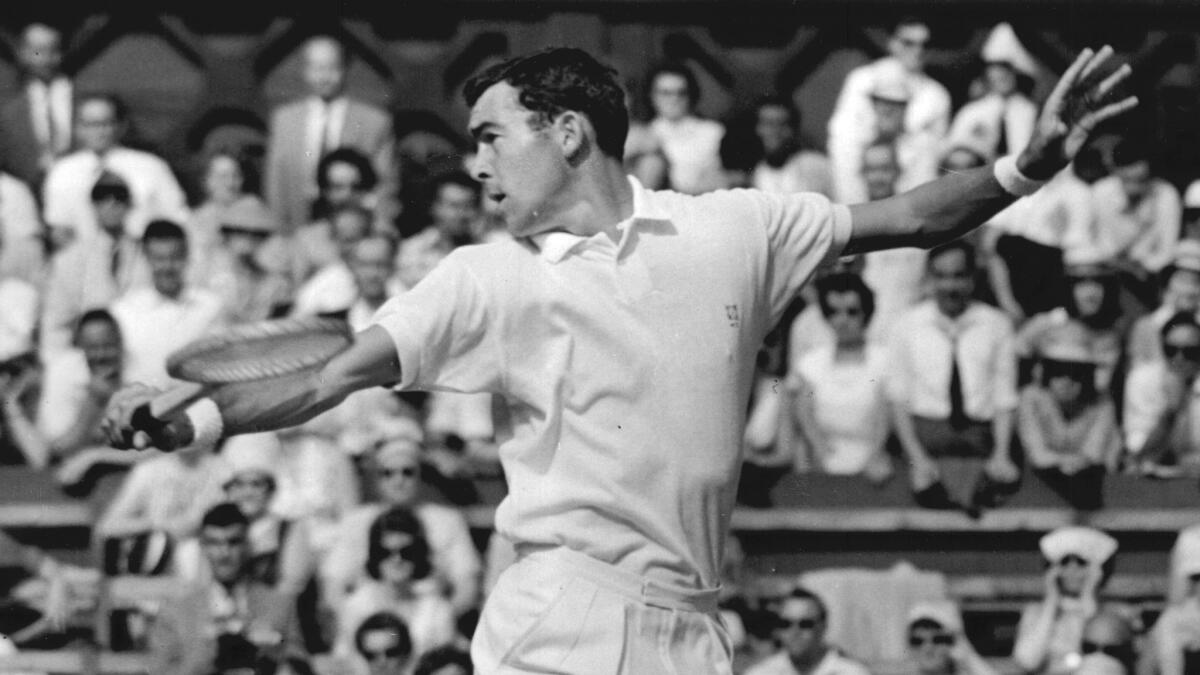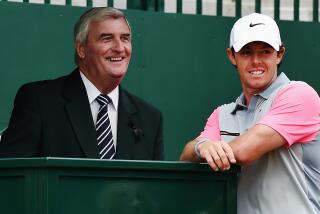Mike Davies dies at 79; tennis innovator brought new color and exposure to game

Mike Davies in action against G Mulloy at Wimbledon Tennis Championship in 1960.
- Share via
It’s not the yellow of the morning sun or of anything it shines upon.
But in the early 1970s, the garish “optic yellow” of the modern tennis ball was the color of change, and Mike Davies, who helped transform tennis from a country club pastime to a billion-dollar sports enterprise, embraced it.
“I remember saying to him, ‘Mike you can’t do this,” Butch Buchholz, Davies’ friend and fellow member of the International Tennis Hall of Fame, said this week. “There’s no way this is going to happen.”
But it did. Even though old-school tennis officials were cold to the idea, Davies introduced the yellow tennis ball at tournaments so home viewers could more easily follow the action on TV.
“Wimbledon was aghast,” he later said.
Davies, who popularized professional tennis with TV-friendly innovations like the colored ball, colored clothing, major pro tours, and top-dollar jackpots, died Tuesday at his home in Sarasota, Fla. He was 79.
Last spring, he was diagnosed with mesothelioma, a condition linked to asbestos exposure. How he got it is unclear, but Buchholz said he may have contracted it in Swansea, the industrial city in Wales where he grew up.
“He was a pioneer,” Buchholz said. “He never lost his passion for tennis.”
Born in Swansea on Jan. 9, 1936, Michael Grenfell Davies first played tennis at 11. He was Britain’s top-ranked player in 1957, 1959, and 1960. In 1964, when he came to California and started teaching at the Jack Kramer Tennis Club in Rolling Hills Estates, he was rated eighth in the world.
But Davies (pronounced Davis) was frustrated. Tennis was a stratified sport, with the International Lawn Tennis Federation drawing an impassable line between amateurs, who were allowed to compete at prestigious venues like Wimbledon, and professionals, who barnstormed through the world on one-night stands for modest pay.
“They wanted ‘yes-sir, no-sir, three-bags-full’ people,” he told the website Wales Online. “I wasn’t like that. I used to say what I thought about this outdated, class-conscious organization, and they didn’t like it.”
In 1968, Davies joined Texas oil heir Lamar Hunt in a breakaway group called World Championship Tennis, which led the way in softening the distinction between amateurs and professionals and paving the way for matches played before huge TV audiences.
“This is a modern age and not a time to be doing things the way people did them 70 years ago,” Hunt told the Los Angeles Times in 1971. “When pro football shows a profit here, the British are horrified. When we fill 50,000 seats, the British say that’s not gentlemanly. I’ve got to believe we have a more progressive outlook here in America.”
As the WCT’s executive director until 1981, Davies created the first tennis tournament series on national TV. He instituted 90-second breaks every two games, allowing for commercials. He sold blockbuster TV contracts and attracted record-breaking audiences; the WCT’s 1972 final in Dallas between Ken Rosewall and Rod Laver drew more than 21 million viewers.
As the sport evolved, Davies went on to head the International Tennis Federation, the Assn. of Tennis Professionals, and the Pilot Pen tournament, which became the Connecticut Open.
Anne Worcester, former director of the Women’s Tennis Assn. and currently tournament director of the Connecticut Open, saw him as a mentor.
“He was definitely anti-establishment and he definitely ruffled feathers,” she said. “All he cared about was to find a way for professionals to be compensated fairly and for creating a commercial marketplace to support that.”
Davies’ survivors include his wife, Mina; four children; and four grandchildren.
In 2012, when he was inducted into the International Tennis Hall of Fame in Newport, R.I., he told a favorite story about setting up a tournament for the shah of Iran.
Davies sent the ITF’s representative in London to meet with an Iranian general and outline the group’s requirements: $50,000 in prize money, a crew of ball boys, and some linesmen with good eyesight.
The general agreed to everything. The money and ball boys were no problem. And a dozen men from the shah’s cadre of snipers would make the calls.
“The players said later that the line calls were exceptionally good,” Davies told the chuckling crowd.
Twitter: @schawkinshttps://www.twitter.com/schawkins
More to Read
Start your day right
Sign up for Essential California for the L.A. Times biggest news, features and recommendations in your inbox six days a week.
You may occasionally receive promotional content from the Los Angeles Times.







